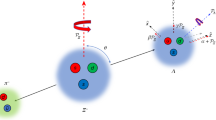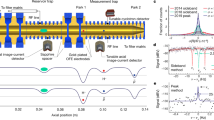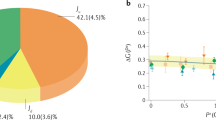Abstract
Symmetry permeates nature and is fundamental to all laws of physics. One example is parity (mirror) symmetry, which implies that flipping left and right does not change the laws of physics. Laws for electromagnetism, gravity and the subatomic strong force respect parity symmetry, but the subatomic weak force does not1,2. Historically, parity violation in electron scattering has been important in establishing (and now testing) the standard model of particle physics. One particular set of quantities accessible through measurements of parity-violating electron scattering are the effective weak couplings C2q, sensitive to the quarks’ chirality preference when participating in the weak force, which have been measured directly3,4 only once in the past 40 years. Here we report a measurement of the parity-violating asymmetry in electron–quark scattering, which yields a determination of 2C2u − C2d (where u and d denote up and down quarks, respectively) with a precision increased by a factor of five relative to the earlier result. These results provide evidence with greater than 95 per cent confidence that the C2q couplings are non-zero, as predicted by the electroweak theory. They lead to constraints on new parity-violating interactions beyond the standard model, particularly those due to quark chirality. Whereas contemporary particle physics research is focused on high-energy colliders such as the Large Hadron Collider, our results provide specific chirality information on electroweak theory that is difficult to obtain at high energies. Our measurement is relatively free of ambiguity in its interpretation, and opens the door to even more precise measurements in the future.
This is a preview of subscription content, access via your institution
Access options
Subscribe to this journal
Receive 51 print issues and online access
$199.00 per year
only $3.90 per issue
Buy this article
- Purchase on Springer Link
- Instant access to full article PDF
Prices may be subject to local taxes which are calculated during checkout


Similar content being viewed by others
References
Lee, T. D. & Yang, C.-N. Question of parity conservation in weak interactions. Phys. Rev. 104, 254–258 (1956)
Wu, C. S., Ambler, E., Hayward, R. W., Hoppes, D. D. & Hudson, R. P. Experimental test of parity conservation in beta decay. Phys. Rev. 105, 1413–1415 (1957)
Prescott, C. Y. et al. Parity nonconservation in inelastic electron scattering. Phys. Lett. B 77, 347–352 (1978)
Prescott, C. Y. et al. Further measurements of parity nonconservation in inelastic electron scattering. Phys. Lett. B 84, 524–528 (1979)
Cahn, R. N. & Gilman, F. J. Polarized-electron-nucleon scattering in gauge theories of weak and electromagnetic interactions. Phys. Rev. D 17, 1313–1322 (1978)
Glashow, S. L. Partial symmetries of weak interactions. Nucl. Phys. 22, 579–588 (1961)
Weinberg, S. A model of leptons. Phys. Rev. Lett. 19, 1264–1266 (1967)
Salam, A. Weak and electromagnetic interactions. In Elementary Particle Theory: Relativistic Groups and Analyticity (ed. Svartholm, N. ) 367–377 (Almqvist and Wiksell, 1968)
Anthony, P. L. et al. Precision measurement of the weak mixing angle in Moller scattering. Phys. Rev. Lett. 95, 081601 (2005)
Czarnecki, A. & Marciano, W. J. Electrons are not ambidextrous. Nature 435, 437–438 (2005)
Abrahamyan, S. et al. Measurement of the neutron radius of 208Pb through parity-violation in electron scattering. Phys. Rev. Lett. 108, 112502 (2012)
Armstrong, D. S. & McKeown, R. D. Parity-violating electron scattering and the electric and magnetic strange form factors of the nucleon. Annu. Rev. Nucl. Part. Sci. 62, 337–359 (2012)
Alcorn, J. et al. Basic instrumentation for Hall A at Jefferson Lab. Nucl. Instrum. Methods A 522, 294–346 (2004)
Subedi, R. et al. A scaler-based data acquisition system for measuring parity violation asymmetry in deep inelastic scattering. Nucl. Instrum. Methods A 724, 90–103 (2013)
Martin, A. D., Stirling, W. J., Thorne, R. S. & Watt, G. Parton distributions for the LHC. Eur. Phys. J. C 63, 189–285 (2009)
Androic, D. et al. First determination of the weak charge of the proton. Phys. Rev. Lett. 111, 141803 (2013)
Wood, C. S. et al. Measurement of parity nonconservation and an anapole moment in cesium. Science 275, 1759–1763 (1997)
Bennett, S. C. & Wieman, C. E. Measurement of the 6S →7S transition polarizability in atomic cesium and an improved test of the Standard Model. Phys. Rev. Lett. 82, 2484–2487 (1999); erratum. 83, 889 (1999)
Ginges, J. S. M. & Flambaum, V. V. Violations of fundamental symmetries in atoms and tests of unification theories of elementary particles. Phys. Rep. 397, 63–154 (2004)
Dzuba, V. A., Berengut, J. C., Flambaum, V. V. & Roberts, B. Revisiting parity nonconservation in cesium. Phys. Rev. Lett. 109, 203003 (2012)
Erler, J. & Su, S. The weak neutral current. Prog. Part. Nucl. Phys. 71, 119–149 (2013)
Beise, E. J., Pitt, M. L. & Spayde, D. T. The SAMPLE experiment and weak nucleon structure. Prog. Part. Nucl. Phys. 54, 289–350 (2005)
Eichten, E., Lane, K. D. & Peskin, M. E. New tests for quark and lepton substructure. Phys. Rev. Lett. 50, 811–814 (1983)
Schael, S. et al. Electroweak measurements in electron-positron collisions at W-boson-pair energies at LEP. Phys. Rep. 532, 119–244 (2013)
Chekanov, S. et al. Search for contact interactions, large extra dimensions and finite quark radius in ep collisions at HERA. Phys. Lett. B 591, 23–41 (2004)
Aaron, F. D. et al. Search for contact interactions in e±p collisions at HERA. Phys. Lett. B 705, 52–58 (2011)
Aad, G. et al. Search for contact interactions and large extra dimensions in dilepton events from pp collisions at with the ATLAS detector. Phys. Rev. D 87, 015010 (2013)
Acknowledgements
We thank the personnel of Jefferson Lab for their efforts which resulted in the successful completion of the experiment, and A. Accardi, P. Blunden, W. Melnitchouk and their collaborators for carrying out the calculations necessary for the completion of the data analysis. X.Z. thanks the Medium Energy Physics Group at the Argonne National Laboratory for support during the initial work on this experiment. J.E. was supported by PAPIIT (DGAPAUNAM) project IN106913 and CONACyT (México) project 151234, and acknowledges the hospitality and support by the Mainz Institute for Theoretical Physics (MITP) where part of his work was completed. This work was supported in part by the Jeffress Memorial Trust (award no. J-836), the US NSF (award no. 0653347), and the US DOE (award nos DE-SC0003885 and DE-AC02-06CH11357). This work was authored by Jefferson Science Associates, LLC under US DOE contract no. DE-AC05-06OR23177. The US Government retains a non-exclusive, paid-up, irrevocable, world-wide license to publish or reproduce this manuscript for US Government purposes.
Author information
Authors and Affiliations
Consortia
Contributions
Authors contributed to one or more of the following areas: proposing, leading, and running the experiment; design, construction, optimization, and testing of the data acquisition system; data analysis; simulation; extraction of the physics results from measured asymmetries; and the writing of this Letter.
Corresponding author
Ethics declarations
Competing interests
The author declare no competing financial interests.
Additional information
J.E. is currently on sabbatical leave at the PRISMA Cluster of Excellence and MITP, Johannes Gutenberg University.
Supplementary information
Supplementary Information
This file contains Supplementary Methods, Supplementary References and Supplementary Tables 1-2. (PDF 244 kb)
PowerPoint slides
Rights and permissions
About this article
Cite this article
The Jefferson Lab PVDIS Collaboration. Measurement of parity violation in electron–quark scattering. Nature 506, 67–70 (2014). https://doi.org/10.1038/nature12964
Received:
Accepted:
Published:
Issue Date:
DOI: https://doi.org/10.1038/nature12964
This article is cited by
-
Leading directions in the SMEFT
Journal of High Energy Physics (2023)
-
Global QCD analysis and dark photons
Journal of High Energy Physics (2023)
-
Physics implications of a combined analysis of COHERENT CsI and LAr data
Journal of High Energy Physics (2023)
-
EFT analysis of New Physics at COHERENT
Journal of High Energy Physics (2023)
-
Impact of the Dresden-II and COHERENT neutrino scattering data on neutrino electromagnetic properties and electroweak physics
Journal of High Energy Physics (2022)
Comments
By submitting a comment you agree to abide by our Terms and Community Guidelines. If you find something abusive or that does not comply with our terms or guidelines please flag it as inappropriate.



